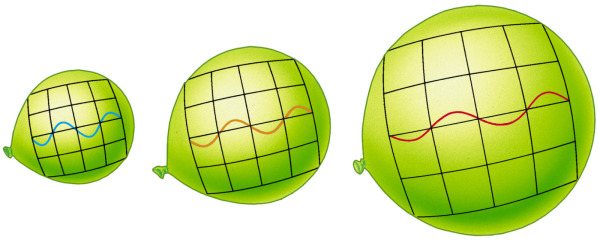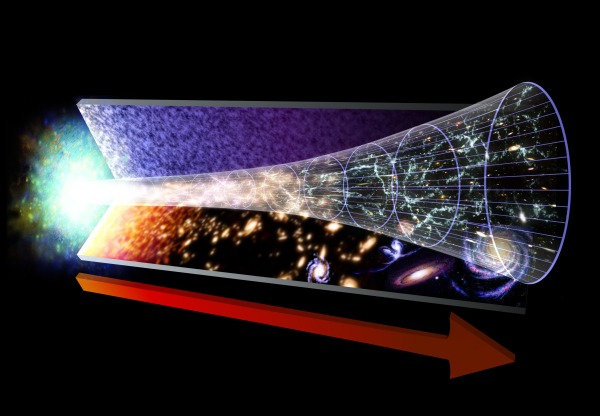“I think one of the coolest things you can do is disappear for a while, because it gives you the chance to re-emerge.” -Josh Homme
The Big Bang -- and General Relativity in general -- teaches us that in an expanding Universe, it's the fabric of space itself that evolves over time. One of the consequences of this is a bit puzzling: that since the Universe was denser in the past, it must have been hotter in the past as well.
But if each individual photon has redshifted to longer wavelengths, and the energy of every photon is inversely proportional to that wavelength, does that mean that energy is actually destroyed in an expanding Universe?
 Image credit: Chris Palma of Penn State / Chaisson and McMillan, Astronomy, via http://www2.astro.psu.edu/users/cpalma/astro1h/class28.html.
Image credit: Chris Palma of Penn State / Chaisson and McMillan, Astronomy, via http://www2.astro.psu.edu/users/cpalma/astro1h/class28.html.
More like this
"Perhaps in time the so-called Dark Ages will be thought of as including our own." -Georg C. Lichtenberg


So if the stuff in the universe is doing work against the universe, i.e. that component of total energy is losing energy, but the real thing pushing the universes expansion id dark energy, wouldn't we expect dark energy to be losing energy, rather than the other way around?
@ Omega
DE energy density is constant with scale/time.. if looking at simplest model of lambda. So from it's point of view, there is more of it, as space gets bigger. How exactly that physically happens, is something I too don't really understand. Guess it's one of the reasons they don't consider DE to be particle like (to some degree), since it would literally mean you get more particles of DE as space expands or they get more energetic... in order for energy density to remain constant.
If energy cannot be created or destroyed, what form of energy existed before the BB?
It is said that the BB happened everywhere at the same time, ergo #1) how could the universe have anything to work against since there is nothing else other than the universe? If that be the case, would it even be possible for a multiverse to exist?
Einstein's field equations, the cosmological constant, the Big Bang, the cosmic background radiation, black holes, supernovae, and the large structure of the universe, all require an isotropic – homogeneous constant. This uniformitarian cosmological constant is not found in what we can observe; therefore, ‘dark matter and dark energy’ have been created by man to account for over 95% of the matter in the universe. This ‘darkened understanding’ (as Romans 1 describes it) is required by the uniformitarian assumption that the universe began with an explosion, and is required to explain the mathematical phenomenon listed above.
Now I’m writing ‘tongue in cheek’ – With man then responsible for creating over 95% of the universe, God should only be getting credit for less than 5%. Therefore, I am reducing my tithe from 10% of my income to less than ½ of one percent. I am calling on all Christians that have not been taught God’s account of creation, or exactly how and why stellar evolution is a lie, to do likewise. If our church leaders cannot teach us the truth about our origins, then by all means, render unto Caesar that which is Caesars, and render unto God that which is God’s. If you are old enough to still hear the Big Bang ringing in your ears, please disregard this message.
@Sinisa: you don't understand it because it doesn't make sense. It only makes sense when you go back to first principles and look afresh at the balloon analogy. The balloon is in a vacuum, and the pressure within it is balanced by the tension in the skin. There's two ways to make it expand. One is to blow in more air, which is in breach of conservation of energy. It's creation ex-hihilo. It's like the saying the DE energy density remains constant, it doesn't make sense. The other way is to make the skin weaker, like it's a bubble-gum balloon. Scale this up to 3D space and IMHO it does make sense.
The gravitational potential of positive matter is negative, PJ. Therefore the positive energy from E=c2 could be equal to the gravitational potential energy it has being inside our universe.
Ergo no net energy is created at the big bang.
No, that's wrong. If you think the balloon is 'in a vacuum' you don't understand the balloon analogy. The surface of the balloon is spacetime; there is nothing in it or around it (as far as we can tell).
That's an unfortunate but inherent problem with analogies, in that they are never perfect and sometimes people actually run the wrong way with them. The useful part of this particular analogy is what is happening to the surface of the balloon. All the rest is mostly not useful and pretty disanalogous to how we understand the physical universe.
Ack, just to clarify, "there is nothing in it" does not mean there is nothing in spacetime. I'm saying actual spacetime has no analog to the air inside the balloon.
@ John
I agree with eric in that it's a bad analogy, especially since what happens in DE case, is very different from what happens i.e. to photons.
With regular things, you have constant number density, meaning if you begin with 3 photons, and scale increases, you still have 3 photons... and it is the energy that goes down... or up, like Ethan said.. if you reverse the process, photons will gain energy.
In DE case, that's not how we think it is. It's energy density is constant..... regardless of scale. Make the volume bigger or smaller, the energy density remains the same.
I was careful to write that I don't understand how physically this happens. Mathematically the conservation is there, from it carrying an opposite sign from gravity (energy density for gravity would have a negative sign... "anti-gravity" would have an opposite sign)... and they cancel out.
I just don't have a mental picture of how physically something like this can happen. Not in terms of formula, but in terms of physical interactions.
p.s. thinking more on subject, I guess it is similar to Dirac sea. In terms that you could think of DE particle and graviton as electron/positron.
The description can't be really same since we do have an accelerating universe and not a steady state one. But that's the only way I could perhaps model energy density being constant in an ever growing volume.
Sinisa,
Two thoughts, neither particularly well thought out but maybe you can chew on them. First, you may have answered your own question in terms of 'mathematically the conservation is there.' In other systems we generally cite a conservation rule as the why for something happening. Why do two billiard balls rebound away from each other exactly the way they do? Because of conservation of momentum and energy. Why does space expand with just the amount of energy to counteract gravity? Because of conservation of energy.
My second thought is from Ethan's earlier article about quarks, and about how pulling them apart produces a third quark once a certain separation distance is reached. This seems almost like a system in which pulling things apart maintains a constant particle number density. It's intriguing (at least to me).
@eric #11: Your idea about the gluon field is intriguing, but not really correct. A somewhat better analogy is to consider the gluon field between two quarks like a spring or a rubber band.
If you hold the ends of a spring and pull them apart, the tension in the spring (the resistive force pulling it back together) gets larger and larger, linearly with the amount of stretch (F = kx). That increasing tension is equivalent to storing energy in the spring (E = 1/2 kx^2). With a rubber band, eventually that stored energy exceeds the "binding energy" holding it together, and the rubber band snaps in half, leaving you with two shorter bands.
As you pull two quarks apart (by some external "magical" method like grabbing them), the energy you use as work goes into the gluon field, and the field get stronger. The expression is not the same as for a spring, but it still increases with distance, rather than decreasing as with EM.
Eventually, the stored energy (in particular, the stored energy _density_) becomes larger than the mass of a couple of quarks, and it becomes possible for a q-qbar pair to appear as real particles. Now you have two pairs of quarks, each with a shorter (and hence lower energy) gluon field binding them.
Michael,
I get that. So the question is: could there be some field or similar mechanism where the "output" of the expansion of space is energy itself. If so, that would explain a constant energy density as it expands. You put E in to expand, and E shows up within the system in another form. At the risk of using an analogy I just called bad, this might be analogous to the force of stretching the balloon causing the plastic to heat up.